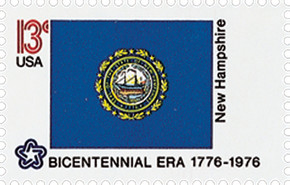
U.S. 1639
1976 Maryland State Flag
State Flags
American Bicentennial Series
• First time a sheet 50 had all different stamp designs
• Part of the American Bicentennial Series
Stamp Category: Commemorative
Series: American Bicentennial Series
Value: 13¢ First-class postage rate
First Day of Issue: February 23, 1976
First Day City(s): Washington, DC
Quantity Issued: 8,720,100 (panes of 50)
Printed by: Bureau of Engraving and Printing
Printing Method: Photogravure
Format: Sheet of 50
Perforations: 11
Why the stamp was issued:
The United States Postal Service celebrated the American Bicentennial with a full pane of the Union’s fifty state flags.
About the stamp design:
Maryland is the only state with a flag design based on English heraldry. The flag bears the arms of the Calvert and Crossland families. Gold and black are the colors that appear in the first and fourth quarters of the flag and represents the Calvert family. Calvert was the family name of the Lords Baltimore who founded Maryland. Crossland was the mother of George Calvert which was the first Lord Baltimore. Crossland is represented in the red and white cross bottony which appears in the second and third quarters.
About the printing process:
Printed by the Bureau of Engraving and Printing on their seven-color Andreotti gravure press (601) which was their work horse for multicolored stamps.
About the American Bicentennial Series:
In the 1970s, America celebrated its 200th anniversary with hundreds of national events commemorating the heroes and historic events that led to our nation’s independence from Great Britain. The U.S. Postal Service issued 113 commemorative stamps over a six-year period in honor of the U.S. bicentennial, beginning with the American Revolution Bicentennial Commission Emblem stamp (U.S. #1432). As a group, the Bicentennial Series chronicles one of our nation’s most important chapters, and remembers the events and patriots who made the U.S. a world model for liberty.
Several of the stamps honored colonial life – craftsmen and communication. Other stamps honored important battles including Lexington and Concord, Bunker Hill, and Saratoga. Significant events such as the Boston Tea Party, the meeting of the First Continental Congress, and the Declaration of Independence were featured as well. The stamps also honored many significant people such as George Washington, Sybil Ludington, Salem Poor, and the Marquis de Lafayette.
Many of the stamps feature classic artwork. For instance, the set of four souvenir sheets picture important events recreated by noted artists such as John Trumbull. The Bicentennial Series also includes an important US postal first – the first 50-stamp se-tenant – featuring all 50 state flags. The format proved to be popular with collectors, and has been repeated many times since.
The American Bicentennial Series is packed with important US history – it tells the story of our nation’s fight for independence through stamps.
History the stamp represents:
On April 28, 1788, Maryland was the seventh state to ratify the US Constitution, an act that admitted it as America’s seventh state.
In 1608, Captain John Smith of Virginia sailed the Chesapeake Bay north into the Maryland region. His written description of the area brought more visitors. In 1631, William Clairborne opened a trading post on Kent Island in the Chesapeake Bay – this was the first colonial settlement in Virginia.
King Charles I granted this area to George Calvert, the first Lord of Baltimore, in 1632. But, Calvert died before he could sign the charter, so his son, Cecilius, the second lord of Baltimore, took his place. The region was named Maryland after the wife of Charles I, Queen Henrietta Maria. Calvert sent colonists to Maryland on two ships, the Ark and the Dove. They arrived at St. Clements Island in the Potomac River in 1634. The colonists established St. Mary’s City near the southern portion of the Western Shore.
In the 1700s, Maryland and Pennsylvania disagreed on their boundary line. Charles Mason and Jeremiah Dixon were contracted to survey the line in 1763. The survey was completed in 1767, and the boundary became known as the Mason-Dixon line.
Maryland was involved in many protests against British policy before the outbreak of the Revolutionary War. Shortly after the Boston Tea Party, Marylanders burned the British ship Peggy Stuart and its cargo of tea in Annapolis. At the First Continental Congress in 1774, Maryland voted against conducting trade with Britain. After the war started, Maryland delegates at the Second Continental Congress voted for independence. The state adopted its first state constitution on November 8, 1776.
Very little fighting took place on Maryland’s soil during the American Revolution. However, Maryland supplied many troops, and its industries built ships and cannons for colonial forces. The Continental Congress moved the capital to Baltimore from December 1776 to March 1777, when Philadelphia was threatened by British troops. After the war, the Continental Congress met at the Maryland State House in Annapolis from 1783 to 1784. George Washington resigned his commission as the commander in chief of the Continental Army in the State House. The Treaty of Paris, which ended the war, was also signed there.
Maryland ratified the United States Constitution on April 28, 1788, making it the seventh state to join the Union. Maryland gave the nation the land to form the District of Columbia, the capital of the United States, in 1791.



















